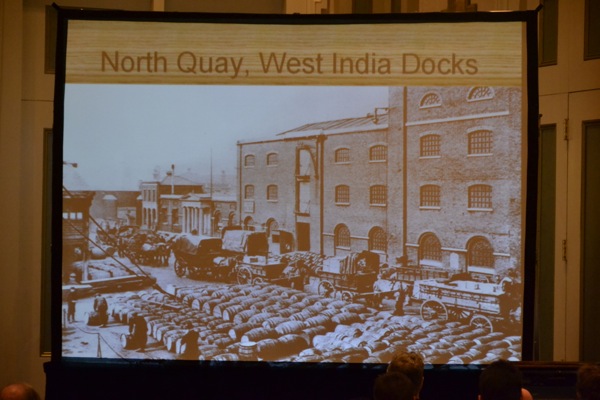Tales of the Cocktail: European Rums: What’s the Story?
August 1, 2013 by Mr. Boozenik
Filed under Spirits Events
Global Rum Ambassador, and rum edu-tainer, Ian Burrell reminded that while we often think of rum as Caribbean, it’s really a European beverage, from the beginning. Europeans brought the cane to the Caribbean and Latin America, brought the distilling talents and equipment, and brought the original money to buy it from the makers, starting in 1493.
Angels and Duppies
Most of us know of the term “Angel’s Share” which refers to the spirt lost lost from a cask to evaporation, as a spirit ages. In Scotland, you lose between 2% and 3% per year. In Kentucky, you can lose 2% to 5% per year, because it’s warmer. But there’s another difference: Scotland is a relatively moist climate, and Kentucky more dry. As a result, Scotland loses more spirit and loses some proof, while Kentucky loses proportionately more water and retains a higher proof.
 |
 |
But the ghosts, or “duppies” in southern climates steal far more from the barrels than the angels further to the North. The “duppy’s share” in Jamaica is generally around 6% per year, and in Venezuela can be up to 10% per year. Given that all of these rums are typically casked and left to mature for 2 or more years, that’s a noticeable share lost fairly quickly.
Partly because of these aggressive “ghosts”, and partly just for simplicity and economy of transport, for centuries, Europeans have been shipping much of the the young rum in casks back to Europe for aging and bottling, rather than shipping the more expensive bottles. Scotland, England, the Netherlands, and even Germany and Italy each developed slightly different traditions of import and aging and brokering and bottling.
Now some brands age only in Europe, some mix Caribbean and European aging. The management of the rum stock has become more sophisticated, too. Some brands or rum houses go so far as to use solera-style aging, to intermingle young and more mature rums.
Tastings
And as with almost all seminars at Tales of the Cocktail, there were some tasty samples to try. Here are just a few notes and impressions of what we were able to enjoy:
- Banks 5 Island Rum was not intended to be a special origin rum initially. They were going for a flavor profile for cocktails, trying to replicate white rums from the 30s, to bring personality back to cocktails which were using white rum. The resulting funky, chewy rum has personality a plenty given all of it’s diverse sources.
- Plantation ages their 3 Star rum in the Caribbean in American oak, and then re-ages in cognac casks in Europe. They are using traditional techniques of altering one or two or three staves’ or changing the lid, if they want more new wood, or want a bit of char added to the flavor profile. The result is smooth, rich and buttery.
- Dos Maderas 5+3 uses a solera system, starting with a couple 5 year old rums (Barbados and Guyana) that is then re-aged in 20 year old Palo Cortado dry sherry. It yields a rich, but fairly dry rum.
- Dos Maderas PX uses that same rum, but matures an additional 2 years in Don Guido 20 year old Pedro Ximenez sherry casks. This rum is rich with sherry, since the sherry casks being reused are wet casks, with some sherry left behind.
- Dos Maderas Luxus matures for 10 years in the Caribbean before 2 more years in PX casks in Europe. The result is deep, intense, and desserty.









